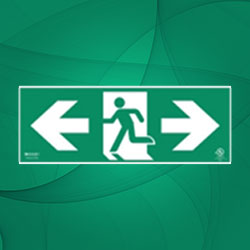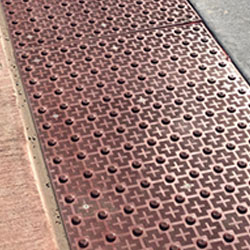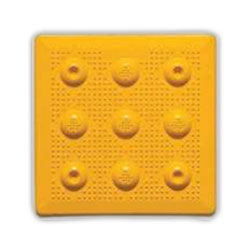

































































































































Creating accessible and navigable public spaces is a crucial responsibility for urban planners, architects, and building owners. For individuals with visual disabilities, seamlessly orienting and traversing unfamiliar environments poses daily challenges.
Thoughtfully designed tactile walking surface indicators for wayfinding offer invaluable sensory cues that empower visually impaired citizens to navigate public spaces confidently and independently. As Canada's leading provider of tactile wayfinding solutions, we outline key considerations for planning inclusive tactile wayfinding in public spaces.
Tactile wayfinding refers to the use of standardized textured ground surface indicators that assist pedestrians who are blind or have low vision by providing directional cues and orientation information. These indicators, commonly called wayfinding tiles or tactile guidance paths, contain raised bars, cones, or grooved patterns installed along pedestrian circulation routes.
By using their cane or feet to detect these tactile cues, visually impaired individuals can discern pathways and amenity locations. Tactile wayfinding enables accessible, independent mobility.
For citizens with visual disabilities, navigating unfamiliar, complex public environments can be daunting. Lack of accessible wayfinding hampers their mobility and prevents equal access to public services and recreational spaces.
Thoughtfully designed tactile wayfinding fosters independence and confidence by providing an intuitive navigation channel. By consulting standards like the CSA B651 and integrating compliant wayfinding tiles in spaces like transit hubs, museums, parks, and malls, planners enable seamless accessibility.
When planning tactile wayfinding systems, consider the following key factors:
Analyze how key origin and destination points within the public space will be linked via accessible pathways marked by tactile indicators. For example, wayfinding tiles can trace routes from transit station entrances to ticket booths, platforms, and exits.
Observe user movement patterns within the space to determine appropriate wayfinding tile placement and routing. Mark the most logical and accessible routes connecting key user areas.
Adhere to relevant provincial and national accessibility standards and building codes, including the AODA and CSA B651, which provide tactile wayfinding specifications.
Maintain consistency in wayfinding tile color, material, texture pattern, and installation methodology throughout the site for cohesiveness and usability.
Wayfinding tiles should enable intuitive orientation by linking together in a logical layout. Cues for direction changes, such as truncated domes at 90-degree turns, are helpful.
Avoid visual clutter and obstacles along tactile routes. Maintain clear sight lines for individuals using canes to optimize usability.
Seamlessly connect tactile wayfinding paths between indoor and outdoor areas and across changes in elevation using ramps, elevators etc.
Choose wayfinding tiles made of durable, slip-resistant materials suitable for heavy pedestrian traffic. Popular options are vitrified polymer composites, metals, porcelain, and ceramic.
Select tile colors that contrast surrounding surfaces for optimal visibility. Prioritize bright, vibrant colors and lower-glare finishes.
Assess wayfinding tile maintainability, modularity, and replacement requirements. Opt for medium to long lifespans of 10-25+ years.
Consider potential underfoot noise from wayfinding tiles. Porcelain, ceramic, and rubber tiles offer quieter alternatives.
Consult Canadian National Institute for the Blind (CNIB) representatives and visually impaired citizens to gain feedback on wayfinding design.
Leverage guidance from accessibility consultants and manufacturers like Tactile Solutions with extensive tactile wayfinding expertise.
By proactively planning wayfinding in infrastructure with code compliant tactile solutions, urban designers and architects can seamlessly transform public spaces to enable accessibility for all citizens, regardless of ability. The considerations above, combined with engagement from visually impaired users and guidance from experts like Tactile Solution Canada, are key to creating accessible environments.
Some examples of effective public space tactile wayfinding include:
Transit Stations: Tactile tiles with bright contrasting colors and parallel bars guide passengers along platforms to boarding zones, ticket counters, information kiosks, etc. Directional domes indicate 90-degree turns towards exits and connecting routes.
Museums & Galleries: Grooved rubber tiles trace pathways through expansive gallery spaces, passing key exhibits and amenities. Porcelain tiles with inlaid arrows provide directional cues leading to specific galleries or the lobby/cafe.
Parks & Public Squares: Durable exterior-grade tactile tiles with high slip resistance mark safe pedestrian routes across parks, delineating open spaces. Bars, cones, and safety yellow truncated domes indicate rest areas, parking, footbridges, etc.
Shopping Malls: Tactile surfaces help shoppers navigate from entrances to shopping aisles, escalators, elevators, and amenities like washrooms, eateries, and customer care.
By consulting accessibility standards and proactively planning tactile wayfinding infrastructure, stakeholders can transform public realm spaces into beacons of accessibility that foster mobility and independence for all citizens.
As Canada's premier accessibility solutions provider, Tactile Solutions partners with urban planners, architects, and property managers to integrate compliant tactile wayfinding systems that make public spaces seamlessly accessible.
Our extensive product range includes industry-leading wayfinding tiles from trusted brands like:
Access Tile® Cast-In-Place Wayfinding Bars - Polymer tiles embedded in concrete walkways.
Access Tile® Surface Applied Wayfinding Bars - Affix tactile polymer tiles onto existing surfaces
Advantage® Tactile Systems Single Bars - Individual stainless steel bars screwed into flooring
Armor Tile® Tactile System - Heavy-duty cast-in-place tactile tiles for outdoors
Elan® Porcelain Wayfinding Tile - Smooth porcelain tiles with inlaid directional arrows
Eon® Tile Rubber Wayfinding Bars - Flexible exterior rubber tiles with bars
Designed for simple installation, weather resistance, and long-lasting performance, our wayfinding products transform public spaces into beacons of accessibility.
A. Key public spaces that call for compliant tactile wayfinding are transit hubs, civic plazas, shopping malls, parks, sidewalks, entertainment venues, tourism sites, and government/institutional facilities.
A. It provides a safe navigation channel for the blind or visually impaired to orient themselves and traverse spaces independently via reliable underfoot cues.
A.The key regulations are the Accessibility for Ontarians with Disabilities Act (AODA), CSA B651 Standard on Barrier-Free Design, and various provincial building codes.
A. Tiles can be surface-mounted on existing flooring using adhesive or mechanical fasteners. They can also be embedded into fresh concrete or asphalt for new construction.
Tactile wayfinding infrastructure thoughtfully planned in accordance with leading standards creates accessible and navigable public realm facilities. By consulting experts like Tactile Solutions Canada and engaging visually impaired citizens, urban designers can employ compliant wayfinding tiles to transform public spaces into beacons of accessibility and inclusivity.
